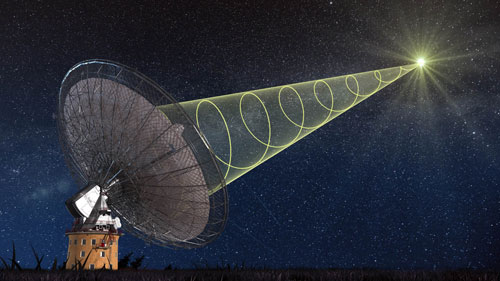| Jan 19, 2015 |
Cosmic radio burst caught red-handed
|
|
(Nanowerk News) Swinburne University of Technology PhD student, Emily Petroff, 'saw' the burst live - a first for astronomers.
|
|
Lasting only milliseconds, the first such radio burst was discovered in 2007 by astronomers combing old Parkes data archives for unrelated objects.
|
|
Six more bursts, apparently from outside our Galaxy, have now been found with the Parkes telescope and a seventh with the Arecibo telescope in Puerto Rico.
|
 |
| A schematic illustration of CSIRO’s Parkes radio telescope receiving the polarised signal from the new ‘fast radio burst’. (Image: Swinburne Astronomy Productions)
|
|
Astronomers worldwide have been vying to explain the phenomenon.
|
|
"These bursts were generally discovered weeks, months or even more than a decade after they happened," Ms Petroff said.
|
|
"We are the first to catch one in real time."
|
|
Confident that she would spot a 'live' burst, Ms Petroff had an international team of astronomers poised to make rapid follow-up observations, at wavelengths from radio to X-ray.
|
|
After the Parkes telescope saw the burst go off, the team swung into action on twelve telescopes around the world – in Australia, California, the Canary Islands, Chile, Germany, Hawaii, and India – as well as spaced based telescopes.
|
|
"We can rule out some ideas because no counterparts were seen in the optical, infrared, ultraviolet or X-ray," CSIRO’s Head of Astrophysics, Dr Simon Johnston said.
|
|
"However, the neat idea that we are seeing a neutron star imploding into a black hole remains a possibility."
|
|
One of the big unknowns of fast radio bursts is their distance. The characteristics of the radio signal – how it is 'smeared out' in frequency from travelling through space – indicate that the source of the new burst was up to 5.5 billion light-years away.
|
|
"This means it could have given off as much energy in a few milliseconds as the Sun does in a day," Ms Petroff said.
|
|
She said identifying the origin of the fast radio bursts is now only a matter of time.
|
|
"We've set the trap. Now we just have to wait for another burst to fall into it."
|
|
The finding is published today in Monthly Notices of the Royal Astronomical Society ("A real-time fast radio burst: polarization detection and multiwavelength follow-up").
|

